Elliptical Printed Dipole Antenna Design using ANN Based on Levenberg–Marquardt Algorithm
Volume 3, Issue 5, Page No 394-397, 2018
Author’s Name: Ali I. Hammoodi1,a), Mariofanna Milanova2, Haider Raad3
View Affiliations
1Department of Systems Engineering, University of Arkansas at Little Rock, 72204, USA
2Department of Computer Science, University of Arkansas at Little Rock, 72204, USA
3Physics Department, Xavier University, 45207, USA
a)Author to whom correspondence should be addressed. E-mail: aihammoodi@ualr.edu
Adv. Sci. Technol. Eng. Syst. J. 3(5), 394-397 (2018); ![]() DOI: 10.25046/aj030545
DOI: 10.25046/aj030545
Keywords: Antenna Design ,Flexible Antenna, Neural Network
Export Citations
A design of elliptical printed dipole antenna based on neural network approach is presented in this paper for recent WiMAX, Bluetooth, WLAN, LTE, and future 5G applications. The dipole patch is printed on top of substrate which has relative permittivity of 2.2 and 0.787mm of thickness. The elliptical dipole antenna is single band and the operational frequency is controlled by the major and minor axes of the ellipse. Neural network composed of one input layer, one hidden layer, and one output layer is implemented using simulated dataset of 24 samples collected using the electromagnetic simulator CST Microwave Studio. The neural network is trained using Levenberg-Marquardt algorithm and we divided the data set into 90% for training, 5% for testing, and 5% for validation. The error, described by the difference between the target data and expected output, is less than 0.005. The neural network model is a promising candidate to implement the design of elliptical dipole antenna to eliminate the simulation time taken by the EM simulator and reduce the cost of using large computing cluster.
Received: 11 August 2018, Accepted: 08 October 2018, Published Online: 18 October 2018
1. Introduction
Single band antennas recently become more demanded designs for modern WLAN, WiMAX, and ISM applications due to the small size and uniform radiated gain with minimized side lobes. The light weight feature, low profile, flexibility, conformability, and ease of fabrication increased the demand of printed antennas in integrated circuit of modern wireless systems [1].
There are various tools of electromagnetic simulators have been used to design and analyze variety of antennas and built using computational electromagnetic analysis which aims to solve Maxwell equations for particular design. The three most common software’s are: Ansoft HFSS, CST Microwave studio and FEKO. Some of these software’s are based on Finite Element Method and some others are based on Finite Difference Time Domain and Finite Difference Frequency Domain as well as Method of Moment. The main disadvantages of these tools are, but not limited to: 1) Complexity of the structure determines the simulation time hence some of the structures could take up to several days , 2) The individual license cost of these tools are extremely high and could go up to thousands of dollars, and 3) requirements of powerful computing machines to handle the simulation structure of these tools and solve the design in considerable time. As a result of these major drawbacks, the approach we believe is the best candidate to overcome these issues is machine learning. This approach could be utilized to implement microwave circuit and antennas designs despite the fact of long simulation time and by this technique we could obtain cost-effective simulator.
There are different machine learning approaches could be used to implement EM simulators, however, Artificial Neural Network (ANN) is the highly recommend technique due to its capabilities in learning of solving complex and non-linear problems in different aspects. The weight of the neural network adjustment depends on the training algorithm and the given data set. Different training algorithms could be used which give different network performance and depends on the type of the problem we are trying to solve, the size of the training dataset and how we divide them to train the model and number of layers we could use to implement the model [2-4]. The technique of ANN has been implemented on several designs with different functionality. One example of E-shaped slot embedded in microstrip patch antenna where the neural network is used to obtain the effect of feeding point on the antenna performance [5]. Another example of C-Shaped patch antenna which is implemented using Bayesian Regularization algorithm to calculate the frequency of operation. A compact triple-band PIFA is implemented using ANN for antenna modeling [6].
This paper presents the design of elliptical shape printed dipole antenna using ANN. The ANN constructs of 1 hidden layers of 10 neurons. The Levenberg-Marquardt algorithm based on backpropagation is used to optimize the model. Parametric study and sensitivity analysis have been done on the design of the printed dipole to measure the effect of each design parameters on the frequency of operation. It is noted that the design of the printed dipole antenna is mostly affected by the major and minor axes of the elliptical shape and the gap between the two ellipses. Therefore, the input of the ANN is considered the desire frequency of operation and the output represented by the major axis of the ellipse, minor axis of the ellipse, and the maximum expected gain at the design frequency. The ANN is train using dataset of 24 samples. The dataset was collected using CST Microwave studio, 2017 [7]. The optimized ANN model is achieved when the dataset is split as 90% for training set, and 5% for both validation and testing. The error is less than 0.005 in all the phases as this error representing the difference between the output of the ANN and the expected value. The ANN presented in this paper is a good approach for the design of single band dipole antenna for modern wireless applications.
The follow sections are divided and summarized as: Section two possess antenna geometry and the antenna performance under one case study. Section three describes the neural network model and analysis. Section four concluded the presented work and followed by the used references.
2. Antenna Geometry and Design
The printed dipole antenna is modeled using CST microwave studio, 2017. The scattering parameters (S-parameters) is used to show the performance of the model using EM simulator. Dipole antenna is built on substrate of 2.2 relative permittivity and 0.787 mm of thickness. The dipole is fed at the center by discrete face port. Figure 1 shows the geometry of the printed elliptical dipole.
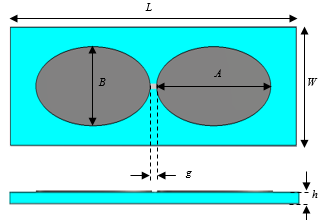 Figure 1. Printed dipole antenna geometry and parameters definition.
Figure 1. Printed dipole antenna geometry and parameters definition.
The numerical method implemented in the CST EM tool is based on Finite Difference Time Domain which is used to solve Maxwell equations for antennas using time domain analysis. The operational frequency of antenna is represented by the S11 and which represents the ratio of the reflected signal to the incident signal. By understanding the design philosophy using sensitivity analysis and parametric study, the operational frequency of the given printed elliptical dipole antenna is controlled by the major and minor axes of the ellipctcal shapes and the gap between the two ellipse is used to achieve impedance matching. One case study of S-parameters is shown in Figure 2 and the design parameters are given in Table 1.
The operational frequency of antenna is given by the point where the S11 is ≤ -10 dB. This criterion is a must to define valid data set hence the leak of the previous research is addressed by using data set with invalid data points to train the network. As shown in Figure 2, the resonance frequency (fo) is equal to 6.28 GHz.
Table 1. Design parameters of the case study
| Parameter | Value | Parameter | Value |
| L | 27.5 mm | A | 11 mm |
| W | 8.25 mm | B | 5.5 mm |
| g | 0.624 mm | h | 0.787 mm |
| S11 |
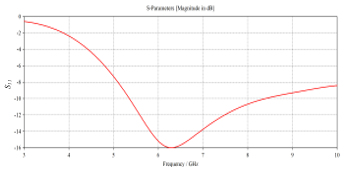 Figure 2. S-parameters of the elliptical shape printed dipole.
Figure 2. S-parameters of the elliptical shape printed dipole.
3. Neural Network Model
There are several undesired factors encouraged the use of neural network approach for the design of antennas and 3D modeling including, the time the simulator takes to solve the structure, the need of powerful computing unit, and cost of purchasing software’s license. As mentioned eariler, machine learning, specifically ANN, is considered as a good candidate to synthesis the design parameters and performance metric of antennas without the need of expesive EM tools. Moreover, implementing designs using 3-D field simulators requiring the understanding of the EM boundaries and requirements for the basic by which the software is built to maintain realistic simulation enviroment.
In this research paper, neural network is used to model the design synthesis of the elliptical printed dipole antenna. The ANN model presented in this paper is built using dataset composed of the S11, realized gain, and antenna’s geometry. The implemented network is build of single input layer of one input parameter which is the antenna operating frequency, one optimized hidden layer of 10 neurons and the output layer is composed of four variables gain (G), major axis (A), minor axis (B), and the gap between the two ellipse (g) as shown in Figure (3).
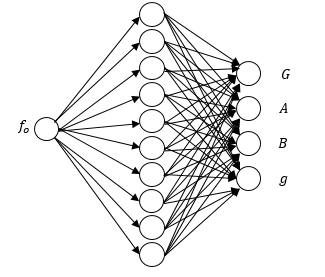 Figure 3. The model of the ANN for the elliptical dipole antenna.
Figure 3. The model of the ANN for the elliptical dipole antenna.
The desired operational frequency is the input to the neural network and the goal of the ANN is to synthesis the the physical dimenions and the realized gain. The simulated data of 24 samples were collected using the well-known EM simulator CST Microwave Studio, 2017. The major factor to make the ANN model succeed in antenna design is to have valid collected data where the requirement of S-parameters ≤ -10 dB is considered. The goal of the implemented ANN is to predict the physical dimenions of the dipole antenna working within the (1-10) GHz as most of the current and modern application work in this frequency band.
The ANN network used is based on the backpropogation technique and the Levenberg-Marquardt algorithm has been used to train the ANN and adjust the weights to predict the parameters of the elliptical printed dipole antenna based on the given operational frequency. In the hidden layer, the neurons compute its trigger value using the activation fucntion given in (1) which shows that each value of basis function for each neuron is a result of multiplying the activation function by the sum of each input multiplies by the weight [2]:
![]() where, φi is the basis function, σ is the activation function (which is a sigmoid function used in this paper), aik is the node weight, and xk is the input value. The system output (y) is described by (2):
where, φi is the basis function, σ is the activation function (which is a sigmoid function used in this paper), aik is the node weight, and xk is the input value. The system output (y) is described by (2):
![]() where, wi is the orthogonal weight. MATLAB is software utilized to model the network. The dataset is divided into 90% for learning, and 5% for both validation and testing. The output regression of the ANN is shown in Figure 4 and the resultant prediction rate is more than 99%. The regression is described by how the predicted output of the neural network in difference phases are align with the given training data after optimizing the weights. The good regression is when the data are aligned along the slop of the regression (Fit).
where, wi is the orthogonal weight. MATLAB is software utilized to model the network. The dataset is divided into 90% for learning, and 5% for both validation and testing. The output regression of the ANN is shown in Figure 4 and the resultant prediction rate is more than 99%. The regression is described by how the predicted output of the neural network in difference phases are align with the given training data after optimizing the weights. The good regression is when the data are aligned along the slop of the regression (Fit).
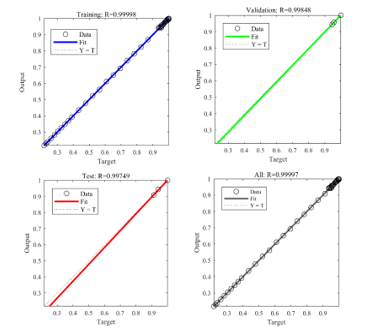 Figure 4. The regression of the neural network in training, validation, and testing phases.
Figure 4. The regression of the neural network in training, validation, and testing phases.
It is noted that the amount of error given by the difference between the output of the ANN and the dataset shown in Figure 5 is below 0.005 over the entire dataset. Therefore, the data set of 24 samples is sufficent to learn the ANN hence the neural network discribed in this paper is a promising candidate for modeling the elliptical printed dipole antenna.
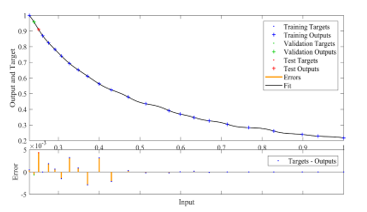 Figure 5. The error between the predicted output and the target output given in the data set.
Figure 5. The error between the predicted output and the target output given in the data set.
4. Conclusion
This paper presents the design of elliptical printed dipole antenna using machine leanring based neural network. The dipole is printed on top of substrate with 2.2 of relative permittivity and 0.787 mm of thickness. The dipole is fed at the center point by discrete port. Based on sensitivity analysis, the three design parameters control the operation frequency of the dipole; major and minor axis and the gap between the two elliptical poles. The dataset is collected using the CST microwave studio, 2017. The the neural network singe input is the desire frequency of operation and the target output is defined by the physical dimentions and the predicted gain. The traing algorithum is Levenberg-Marquardt which is based on backpropagation. The data set is divided into 90% for learning, and 5% for both validation, and testing. The error difference between the output of the trained network and the target output is less than 0.005. The ANN is highly recommended candidate for the design of elliptical printed dipole single band antenna to avoid the time consumed using EM tools, and the requirement of powerful computing servers.
- C. A. Balanis, Antenna Theory: Analysis and Design. Wiley, 2016.
- Livingstone, D.J. Artificial Neural Networks: Methods and Applications. Humana Press, New York, 2009.
- V. S. Kushwah and G. S. Tomar, “Design and Analysis of Microstrip Patch Antennas Using Artifical Neural Network,” in Trends in Research on Microstrip Antennas, InTech, 2009, pp. 720–724.
- V. V Thakare and P. Singhal, “Microstrip Antenna Design Using Artificial Neural Networks,” Int. J. RF Microw. Comput. Eng., pp. 210–224, 2009.
- G. Singh and S. Kaur, “Design Analysis of an E-Shaped Slot Loaded MPA and Parameters Estimation using ANN,” in International Conference on Computing, Communication, and Automation (ICCCA2016), 2016, pp. 1404–1408.
- R. Vanna and J. Ghosh, “Modeling of a compact triple band prF A using Knowledge based neural network,” in 2016 IEEE Region 10 Conference (TENCON), 2016, pp. 2190–2192.
- CST Microwave Studio, 2017.
Citations by Dimensions
Citations by PlumX
Google Scholar
Scopus
Crossref Citations
- Fatih Ozkan Alkurt, Merve Erkinay Ozdemir, Oguzhan Akgol, Muharrem Karaaslan, " Ground plane design configuration estimation of 4.9 GHz reconfigurable monopole antenna for desired radiation features using artificial neural network ." International Journal of RF and Microwave Computer-Aided Engineering, vol. 31, no. 8, pp. , 2021.
- Nayan Sarker, Prajoy Podder, M. Rubaiyat Hossain Mondal, Sakib Shahriar Shafin, Joarder Kamruzzaman, "Applications of Machine Learning and Deep Learning in Antenna Design, Optimization, and Selection: A Review." IEEE Access, vol. 11, no. , pp. 103890, 2023.
- Rida Gadhafi, Abigail Copiaco, Yassine Himeur, Kiyan Afsari, Husameldin Mukhtar, Khalida Ghanem, Wathiq Mansoor, "Exploring the Potential of Deep-Learning and Machine-Learning in Dual-Band Antenna Design." IEEE Open Journal of the Computer Society, vol. 5, no. , pp. 566, 2024.
- Peyman Mahouti, "Application of artificial intelligence algorithms on modeling of reflection phase characteristics of a nonuniform reflectarray element." International Journal of Numerical Modelling: Electronic Networks, Devices and Fields, vol. 33, no. 2, pp. , 2020.
- Aneeqa Bibi, Syed Nazim Shah, Shoaib Azmat, Jamal Nasir, "Levenberg-Marquardt based ANN for design of Rectangular Dielectric Resonator Antenna for LTE Application." In 2022 Third International Conference on Latest trends in Electrical Engineering and Computing Technologies (INTELLECT), pp. 1, 2022.
No. of Downloads Per Month
No. of Downloads Per Country
